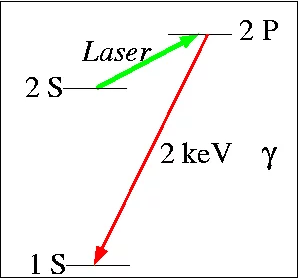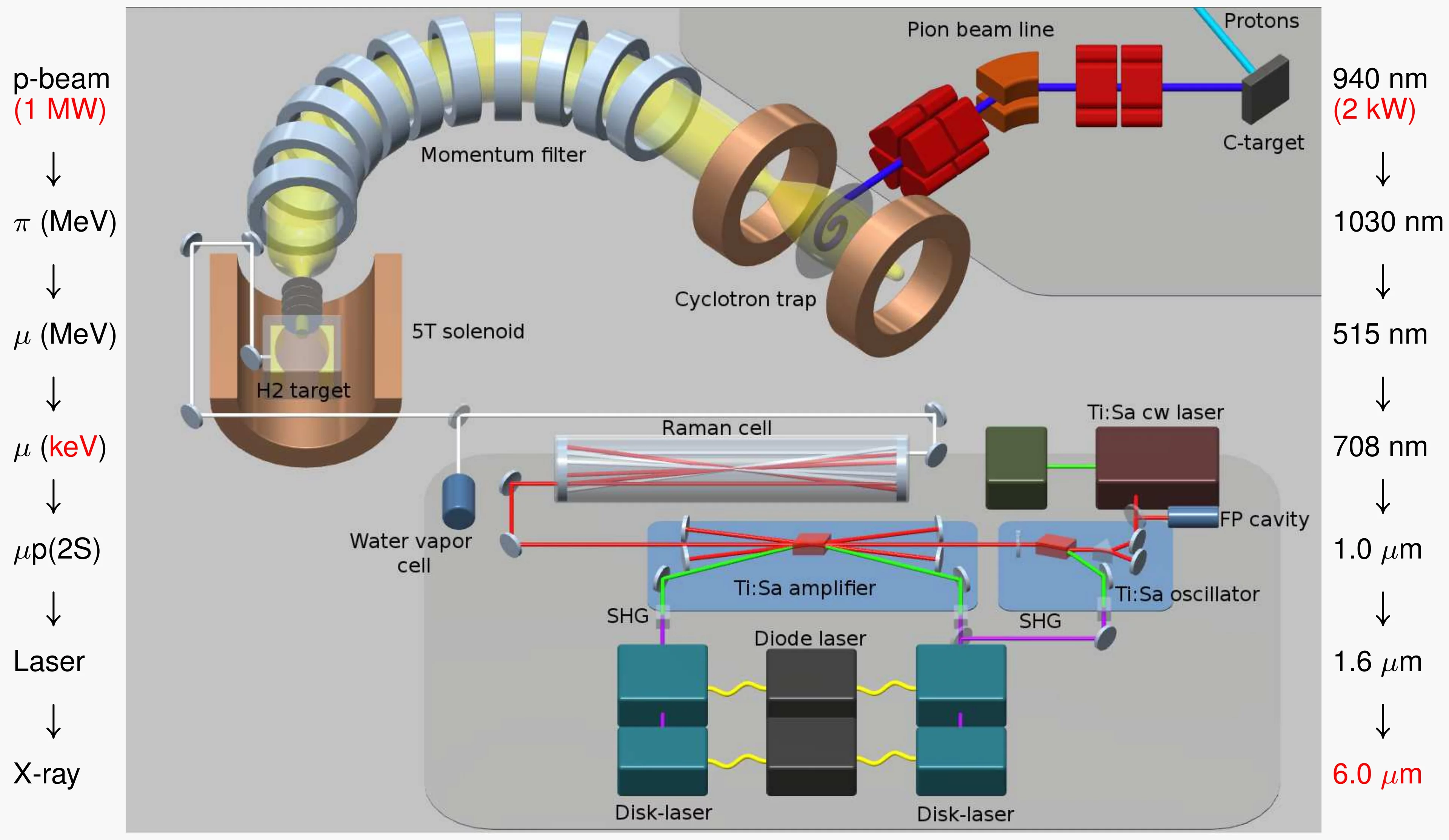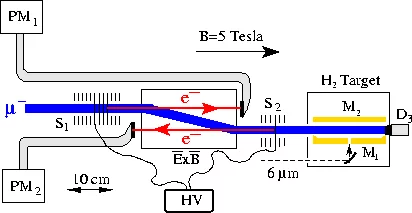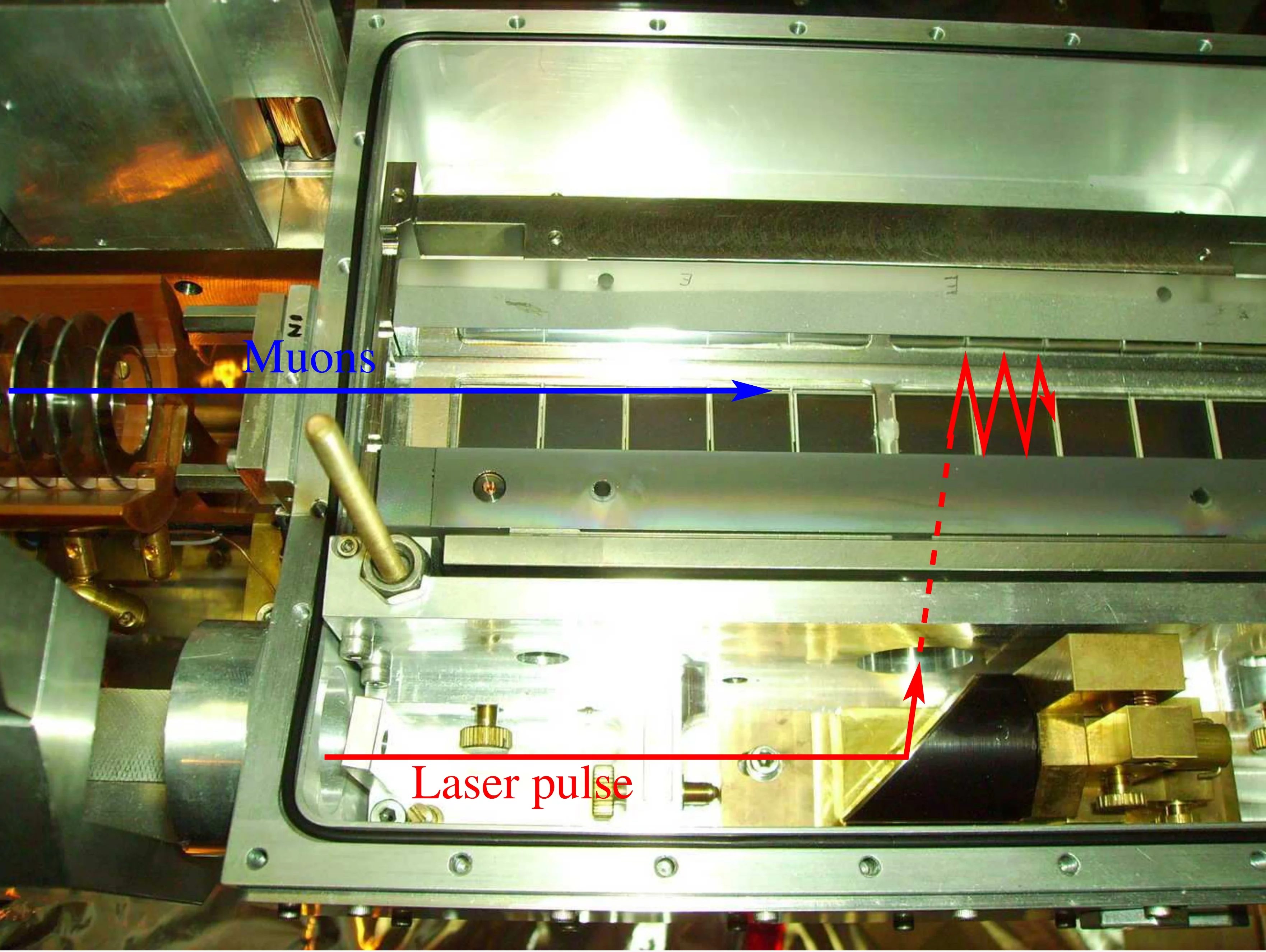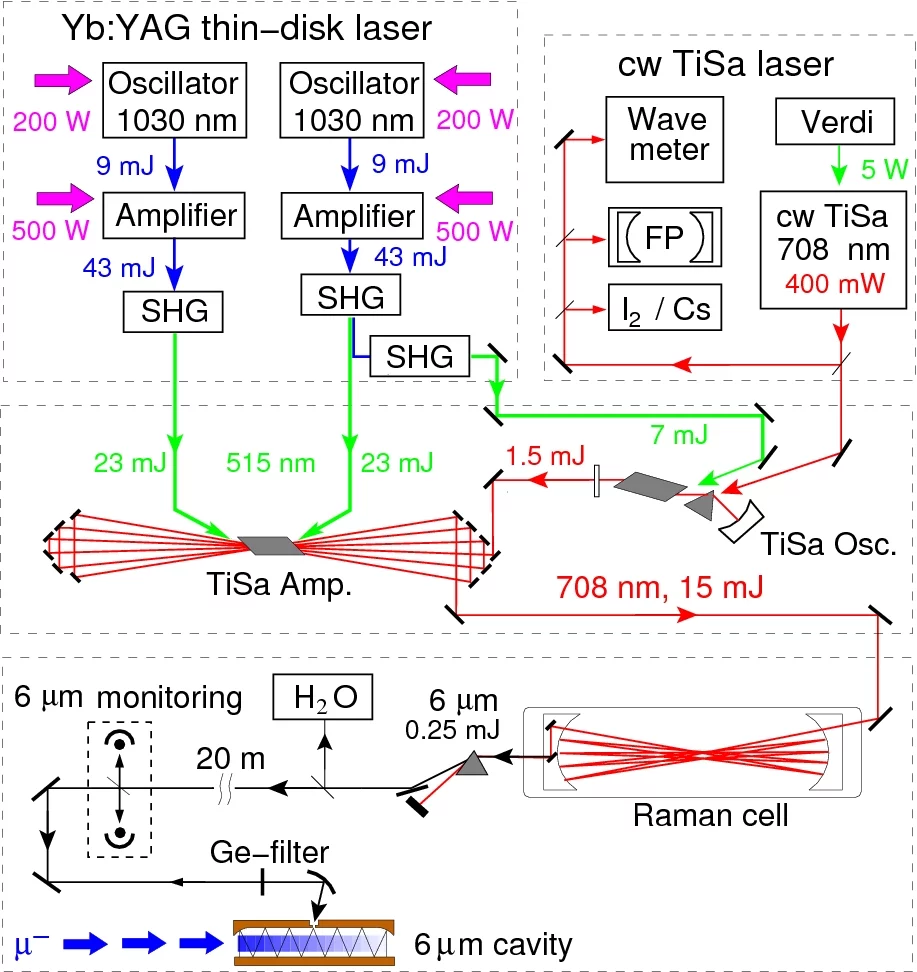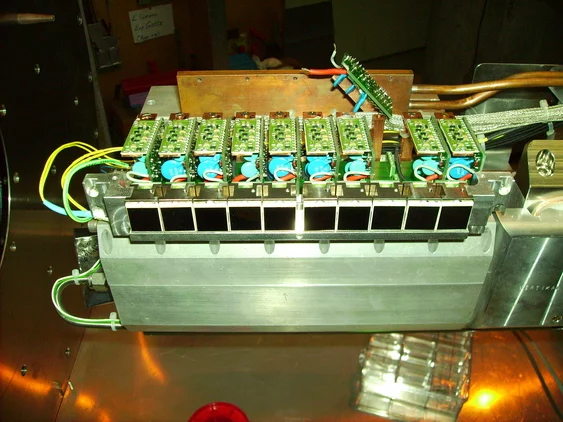The principle of the μp, μd and μHe+ Lamb shift experiments is to form the muonic atom in the 2S-state, and then measure the 2S-2P energy splitting by means of laser spectroscopy. From the measured transitions the corresponding nuclear radii can be determined when combined with the theoretical predictions. In the following, for simplicity we describe only the muonic hydrogen experiment. For the other atoms the following numbers are different but the scheme of the experiment is completely identical. Negative muons (μ−) from the proton accelerator of the Paul Scherrer Institute, Switzerland, are stopped in H2 gas at 1 hPa, where highly excited μp atoms are formed. Most of these de-excite quickly to the 1S-ground state but - 1% populate the long-lived 2S-state whose lifetime is 1 μs. A laser pulse with a wavelength tunable from 5.5 to 6 μm and 0.15 mJ energy illuminates the target gas volume, about 0.9 μs after the muon reached the target. On-resonance light induces 2S-2P transitions, which are immediately followed by 2P-1S de-excitation via 1.9 keV x-ray emission (lifetime 2P = 8.5 ps). A resonance curve is obtained by counting the number of 1.9 keV x-rays in time-coincidence with the laser pulse. From the resonance position the proton charge radius was extracted.
The experiment make use of the worldwide most intensive proton beam delivering 1.4 MW protons at 590 MeV energy. Protons impinging on the C-target produce pions which are transported via magnetic quadrupoles and dipoles to the experimental area where they are injected into a cyclotron trap. Here they decay into MeV-energy μ− which are decelerated by a thin foil placed at the trap center. The resulting keV-energy μ− leave the trap and follow a toroidal magnetic field of 0.15 T (acting as a momentum filter) before entering a 5 T solenoid where the hydrogen target is placed. A μ− entrance detector provides a signal that triggers the multi-stage laser system. About 0.9 μs later, the formed μp is irradiated by the laser pulse to induce the 2S − 2P transition.
Inside the 5T magnet
The 20 keV muon beam transported by the toroidal solenoid is focused into a 5 T solenoid where the hydrogen target is placed. Before stopping in the hydrogen gas the muons are detected in a non destructive way. Two stacks of ultra-thin carbon foils (d = 20 nm) are used for the muon detection. Muons entering the foils of the first stack (S1) eject a few electrons which are accelerated in an electric field. Both muons and electrons enter the E x B separator. The fast electrons follow the magnetic field lines while the path of the slow muons is shifted downwards by about 10 mm. The electrons are detected in a scintillator read out by a photomultiplier (PM1). The muons cross the second stack of foils (S2) and again eject electrons. Some electrons are emitted backwards and detected by PM2. The detection efficiencies measured for S1 and S2 are 87% and 42%, respectively. If a muon induces a signal in both S1 and S2 detectors with the correct time delay, there is a "good" muon entering the target. If in addition no signal is detected in D3, the muon is accepted and a trigger for the pulsed laser and the data acquisition system is delivered. The correct time delay is given by the time-of-flight corresponding to muon kinetic energies in the range from 3 to 6 keV. A rate of 300 triggers per second was obtained.
Laser System
The signals with the correct TOF coincidence are used to trigger two parallel Yb:YAG thin-disk laser systems. The laser system has to provide the pulse within 1 μs because of the limited lifetime of the 2S state due to muon decay and collisional de-excitation. The short laser delay is achieved by the continuous 1.5 kW pumping of two Q-switched thin-disk lasers operating in prelasing mode. Each thin-disk laser system is a Q-switched oscillator followed by a 12-pass amplifier. The two parallel thin-disk amplifiers boost each pulse of 9 mJ from the oscillators to 43 mJ. A frequency doubling stage is used to convert the two disk-laser pulses from 1030 nm to 515 nm which is a suitable wavelength for the pumping of the Titanium-Sapphire (Ti:Sa) laser. The frequency of the pulsed Ti:Sa laser is controlled by injection seeding the Ti:Sa oscillator with a single-mode cw Ti:Sa laser. The Ti:Sa pulses with 12mJ energy and 5 ns pulse length are coupled in a Raman-shifter operated with 15.5 bar H2. The wavelength conversion from the visible 708 nm to the infrared 6 μm (0.25 mJ) occurs via the third-Stokes Raman effect. In our conditions, efficient Raman conversion needs a pulse length of ca. 5 ns with TEM00 mode. The 6 μm light is transported over a 25 m long path to the mirror cavity inside the 5 Tesla solenoid where the muons are stopped. Two mirrors with a high reflective coating for 6 μm wavelength (R=99.91%) are located on the left and right side of the muon stop volume forming a non-resonant multi-pass transverse cavity. One of the mirrors has a hole of 0.6 mm diameter where the laser light enters, and also partially exits, the cavity. The exiting light is guided to an infrared detector (with ns rise time) which gives a diagnosis of the light circulation in the cavity. The calibration of the light in the 6 μm region is achieved by means of water vapor spectroscopy.
The muonic hydrogen Lamb shift experiment places stringent requirements on its laser system:
- Triggerability and Repetition Rate
The laser has to be triggerable on muons entering the apparatus at random times, with a trigger-to-pulse delay smaller than 1 μs (in accordance with the 1 μs lifetime of the 2S state at 1 hPa pressure), and with a dead time between two laser shots shorter than 5 ms. - Pulse energy
A pulse energy of 0.25 mJ (@ 6 μm) is required to sufficiently illuminate the volume where the μp atoms are formed. - Reliability
Because the expected rate of laser-induced events is just a few per hour, the reliability of the whole system during the measuring time of several weeks is essential. - Wavelength
The required scanning range for the laser should be from 5.5 to 6.1 μm in order to cover the several atomic transitions in muonic hydrogen and deuterium
X-Ray Detectors
Our experiment requires the detection of 1.9 keV x-rays from muonic hydrogen 2P-1S transitions. There are several critical constraints restricting the possible choices for the x-ray detectors. The apparatus is installed in an environment with a rather high level of neutron-induced backgrounds as well as electromagnetic and acoustic noise. The 1.9 keV x-ray detector has to reach an energy resolution of 25% and a time resolution better than 50 ns. To optimize the solid angle for x-rays, the detector has to be mounted as near as possible to the pencil-shaped volume where the muonic hydrogen atoms are formed. There is space for two sets of x-ray detectors (with sensitive areas of up to about 17 cm2) at the top and bottom side of the gas target which is mounted inside a solenoid with 20 cm inner diameter. The magnetic field of 5 Tesla produced by this solenoid represents another limitation for the detector choice. In addition, the whole target and detector setup is placed in vacuum. In the end only large area avalanche photodiodes (LAAPD) fulfilled all the requirements.
For an optimal measurement of the 1.9 keV x-ray line, we cooled the whole mount to -30oC. The resolutions (FWHM) obtained for 5.9 keV x-rays varied between 11% and 20%, with an average of about 15%. The typical bias voltage was around 1600 V, at a gain of about 400, a value chosen for each LAAPD so that the amplitude of the 1.9 keV x-ray signal was sufficiently above the noise level without worsening the resolution. After the preamplifiers, the amplitude of a 1.9 keV x-ray signal was about 2 mV, with 50 ns rise time. After further amplification the signals were stored in an 12 bit wave-form digitizer, operated at 250 MHz, which allowed an optimal suppression of background signals with non-standard shape and, in particular, the separation of two consecutive, superimposed pulses.


